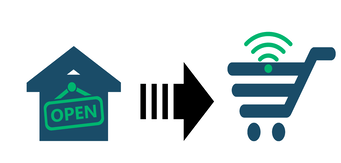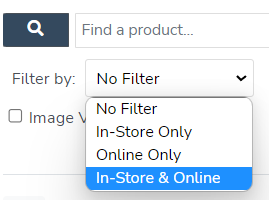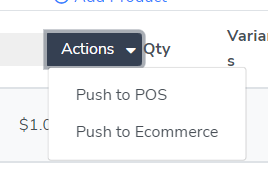This article talks about how pushing products works and how you can use it to migrate your catalog from one platform to another.
Quick Navigation Menu
What do you Mean By Linking and Syncing Relationship?
When will I use this tool?
If you have items that are exclusively on one of your two platforms and want to start selling them on both POS and eCommerce, SKU IQ can help you achieve that without the hurdle of recreating your items from scratch. This guide will show you how to migrate products from one platform to the other using SKU IQs pushing features.
If you already have the same items on your POS and eCommerce and just need them to communicate stock adjustments between both platforms, you'll want to check this article instead.
What does Pushing mean?
Pushing products is the easiest way to copy an item from one platform to the other without having to do double data entry. If most, if not all, of your items are on one platform, you'll likely want to use this feature to do a catalog migration.
When you push your inventory from one platform to another, SKU IQ sends that item data across and uses it to create an identical copy of your chosen item. It will also organically establish a syncing relationship between this new item and the original one so that, going forward, any stock changes are communicated between both platforms automatically.
We call this syncing relationship a product link, which allows the products to "talk" to each other, informing the other platform if there has been a change to the product. For example, if you've pushed an item from your eCommerce to your POS, and a sale on your POS causes a decrement in the inventory, the original item on your e-commerce would also receive that inventory decrement automatically.
If you have a very large inventory, we also offer Bulk Pushes so that you do not have to do your migration manually. See this article for more information and pricing.
Why is Pushing Important?
Rather than doing double data entry by manually creating each item on both platforms and then manually adjusting your inventory, you'll be saving time and effort by allowing SKU IQ to do all the heavy lifting for you.

What do you Mean By Linking and Syncing Relationship?
A link (also referred to as a linking or syncing relationship) is what maintains the connection between your Point of Sale and eCommerce items. Forming a syncing relationship is like placing a mirror between your Point of Sale and eCommerce so that the correct inventory quantities are reflected on both sides.
Unlinked products also do not have the ability to sync product attribute data! So if you want to make your life easier and sync product attributes too. be sure your items are syncing, and check out our integrations page for more information on your platform capabilities.
Manually Pushing Products
Manually pushing products allows you to pick and choose what items you want to send to the opposing platform. This is handy if you have some items that you sell in-store that you don't necessarily want to sell online.
⚠️ SKU IQ will always sync data respecting the limitations of each platform, for example, many platforms will not accept images or will only accept certain image types, SKU IQ is not able to overwrite these. You can check out your platform's specific integration page for more information here.
Many platforms also have limitations on how many variants per item can be accepted (see details here).
1. Filter Your Inventory
When you first connect your platforms to SKU IQ, your POS and eCommerce items will be populated under the Products page. You can use the Filter By dropdown menu to narrow down what items you see, especially if you have linked items.

Linked items will show up under In-store & Online while items that are only on the Point of Sale will show up under In-Store Only and items that are only on your eCommerce website will show up under Online Only. No Filter will show all products, including those that don't exist on either platform and only exist on SKU IQ. You can also use the Hide Sold-Out checkbox to only see items that have positive stock quantities.
Choose your filter according to the platform your items are originating from, or, if you know the item you want to push by name, you can type that into the search box at the top of the filters.2. Select your items
Once you've decided what items you'd like to push, click the checkboxes next to them like the image below.

Each page contains 50 items. You can select all 50 by clicking the checkbox at the very top of the list. If you change pages, your previous selection will be undone, so do this one page at a time.

⚠️ Make sure that the items you've selected exist on only one of your two platforms to avoid any future problems. For instance, if you push an item that already exists on your website to eCommerce, it will duplicate that item, which may cause you issues like overselling.
3. Push your items

Once your items are selected, a black Actions button will appear at the top of the product list. When you click the button, a drop-down menu will appear giving you the option to Push to POS or Push to eCommerce. Here you'll want to select where the items are going to, so if you are pushing items from your eCommerce site, you will want to select Push to POS (and vice versa).
💡 Tip: You may want to start with one or two products to ensure that you are comfortable with SKU IQs syncing capabilities.
3. Once you have selected Push to POS or Push to eCommerce, a popup will appear letting you know you are about to push a specific number of items to the respective platform. It will also give you an estimate of how long the migration of items will take.
When you're ready, click Cool, do it!
Each product takes a few minutes to send over to the opposite platform. 50 products will typically take anywhere from 40 to 60 minutes to finish.
🚨 During your Free Trial, you are limited to pushing a maximum of 50 products. You will be alerted when you have reached that threshold.
Once you have signed up for a paid subscription, there is no longer a limit on how many items you can push. However, only 50 items can be pushed at a time (meaning 50 products per roughly an hour). You cannot do multiple 50-product pushes at once. To get around this constraint, you can purchase and schedule a Bulk Push by contacting Support. See this article for pricing information.
5. After your products are pushed, you can view them by going to Products and filtering to In-Store & Online. You'll see both the Point of Sale and eCommerce icons, as well as the blue circular icon (AKA the Linked Icon) for the products that have been pushed over. This is how you tell that a product has formed a syncing relationship between your Point of Sale and eCommerce platforms.

Automatic Pushing
As an optional feature, SKU IQ offers you auto-push, which allows you to select one of your two platforms to act as a hub for new items. Whenever the chosen platform receives new items, it will automatically push them to the other platform. This prevents you from having to go into the SKU IQ dashboard to perform manual pushes when you add new product.
We have two options available for Auto-Pushing:
1. We can push items directly as published items (so that they appear as live on your website or Point of Sale)
2. We can push items as draft or disabled items (so that they do NOT appear as live products on your website or Point of Sale)
The latter option allows you to edit the product that is in draft status before publishing it. This is handy if you are pushing from a Point of Sale that does not like pictures or can't send descriptions over to your eCommerce site.
If you are interested in setting up automatic pushing, please contact Support so that we can help you set that up appropriately.
